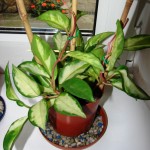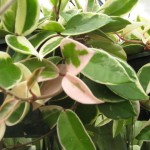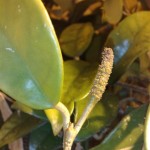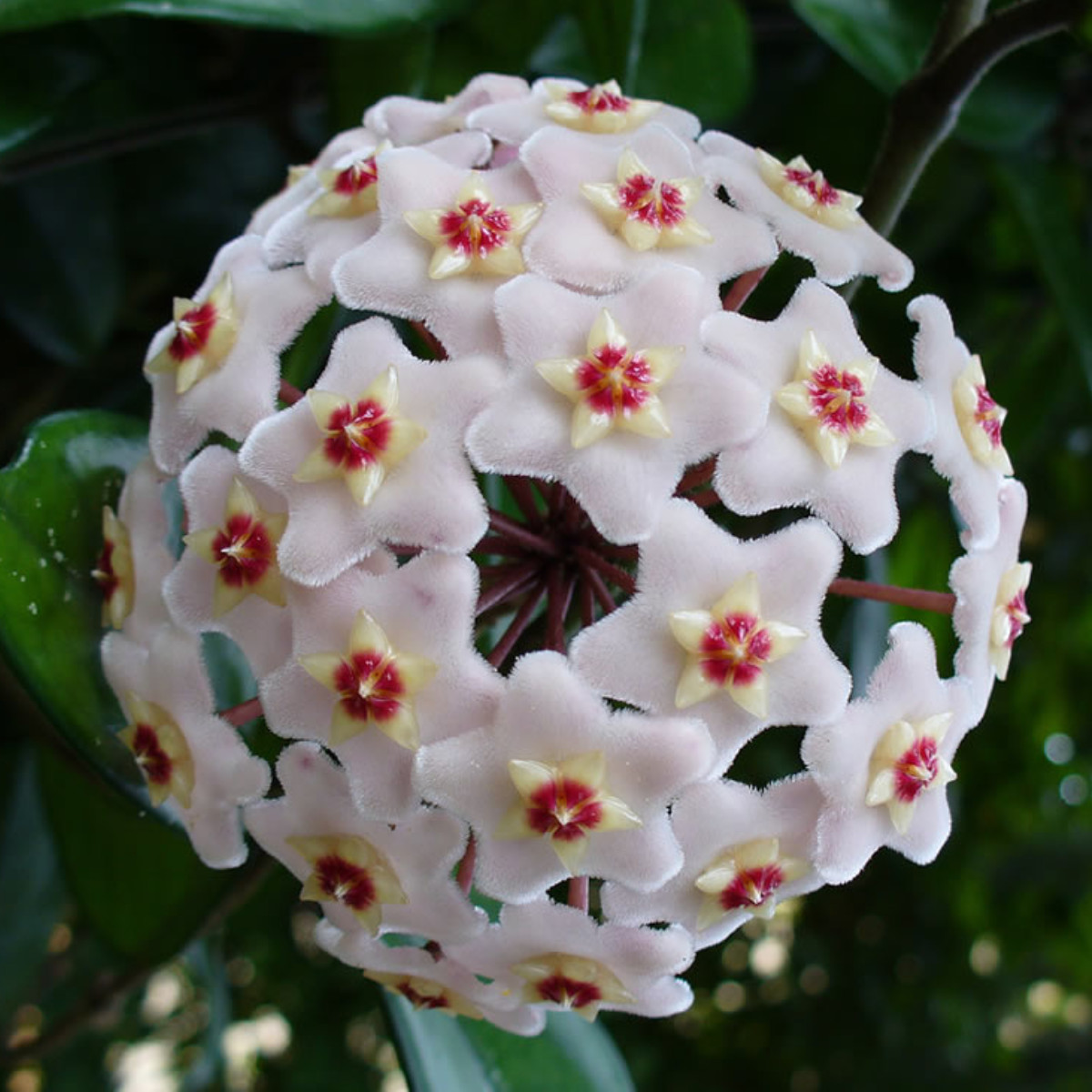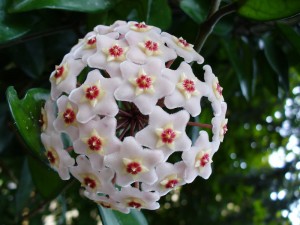Family: Apocynaceae
Synonymous: Asclepias carnosa
Distribution and habitat: Hoya carnosa is one of the many species of Hoya that are native to Eastern Asia and Australia.
Hoya carnosa grow in lowland tropical rainforests where they wrap around or hang high in the trees. They are semi-epiphytic (not parasitic) and like constant moisture (around 5000mm (200 inches) of rain per year) and high humidity. In wild, Hoyas that climb more often they not start growing at ground level, gradually working their way upwards towards light or others scrambles over rocks, growing continuously and reaching lengths of 6m (20 feet) or more.
Description: Hoya carnosa is a fast growing climber with glossy, elliptical, dark green leaves 8cm (3 inch) long and 2cm (0.8 inch) wide. The leaves grow in opposite pairs and have short leaf-stalks.Hoya carnosa is a common house plant grown for its attractive waxy foliage and sweetly scented flowers. Flowers are growing in clusters of convex umbel of 10 to 30 are white to very pale pink, always with red centre. The flowers are star-shaped and their surface are covered in tiny hairs giving them a fuzzy sheen appearance. They are 1-2cm (0.4-0.8 inch) wide carried on a woody spur about 2cm (0.8 inch) long which arises from the leaf axil. The long lasting clusters of flowers are produced every year - normally throughout the summer - on 3-5cm (1-2 inch) long stalk. These flowers which last about one week produce lots of nectar and have a strong sweet fragrance that it can fill an entire room at night.
Houseplant care:Hoya carnosa is one of the easier Hoya to care for. It can tolerate the drying climate of a room better than other members of the genus and it is less vulnerable to cold temperatures.
When grown indoors - the climbing Hoya carnosa can grow quite tall - are usually grown on small trellises or are trained around wire or stakes. When is young and small look attractive when grouped together in a hanging basket.
The flowers sometimes drip sticky honeydew that could make mess on furniture.
Allow the flowers to dry and fall off on their own. Hoya spurs produces flowers year after year. By removing spurs (little leafless stem) will has as effect a reduced flowers quantities for the future.
The plant'slong vines can be pruned back to keep it compact or instead, prune the main stem to encourage more side shoots that may produce flowers later. The best time to prune is early spring, before Hoya carnosa start their most vigorous time of growth.
Light: Three to four hours a day of sunlight are essential for healthy growth and flowering. Harsh afternoon sun can burn the leaves, so it is best to place the plant where it will receive early morning or late afternoon sun. PlaceHoya carnosa plant in a sunny, south- or west-facing window for the best results. Also, Hoya carnosa will grow well in artificial light.
If a Hoya carnosa is mature but has not bloomed, it is usually because it is not getting enough light. Keep it in bright, indirect light for best results.
The flowers will always face toward the brightest light. Do not turn the plant when flower buds are forming or it may abort the blooming process.
Temperature: Normal room temperature are suitable for these plants. Keep the air temperature above 10C (50F) in winter and provide temperatures of 16 to 21C (60-70F) in summer.
Water: During the active growth period water moderately, allowing the top centimetre (0.4 inch) or so of the mixture to dry out between waterings. During the rest period water only enough to keep the mixture from drying out.
Fertilising: Give Hoya carnosa a high-potash liquid fertiliser once every two weeks during the active growth period only.
Potting and repotting: Use a soil based potting mixture. Move climbingHoya carnosa into pots one size bigger each spring until maximum convenient pot size is reached. Move trailing plants on only once in two years. After reaching maximum pot size, top-dress these plants instead of moving on. Never repot a plant when it is in bloom because it may drop its flower buds.
Propagation: Propagate Hoya carnosa in spring by means of stem cuttings 8-10cm (3-4 inch) long. Take each cutting immediately below a pair of leaves, dip the cut end in a hormone rooting powder and plant two or three together in a 5-8cm (2-3 inch) pot containing a moistened equal parts mixture of peat moss and coarse sand or perlite.
Enclose the whole in a plastic bag or propagating case and stand in medium light until rooting occurs (normally, in six to eight weeks). Uncover the new plants and begin to water them sparingly. After future top growth appears, start regular feeding. About three months after the start of propagation move the new plants into soil-based mixture and treat them as mature Hoya carnosa.
Problem: Hoya carnosa is generally trouble-free.
Overwatering will result in leaves turning brown.
Hoya carnosa that dry up and drop their buds have been allowed to become too dry between waterings.
They will also drop their buds if the potting mixture is constantly kept too wet.
Do not move the plant when buds are forming because changes in light may cause them to drop. Raising the humidity can help.
However they do not dry up in this case but become yellow and spongy or brown and mushy. The buds that open but fall off soon after are probably placed where a cool draft is hitting them, maybe from a fan.
The tip ends of the new growth of Hoya carnosa dies off. The causes of stem tip burn can be: low humidity, overfertilising, stems touching a cold or hot surface.
Hoya carnosa can be attacked by mealy bugs (white cottony patch) and scale insects (small brown insects that cling to stems and leaves, secreting a sticky residue on the plant).
Treatment: Treat the plant against mealy bugs and scale insect with a mix of a little mild dishwashing detergent with water and spray the infected plants. The soap will coat and suffocate the insects. Rinse the plants off with clean water to make sure the pores on the leaves are open so the plant can breathe.
Sometimes tiny little little black flies that fly around potted Hoya carnosa plants. These are Fungus gnats (Bradysia species). They lay eggs in the potting mix. The eggs hatch out into tiny almost microscopic worms that feed on the peat moss and often on the roots of plants.
Treatment: A very small amount of a systemic pesticide watered into plants every five weeks or so, will get rid of them.
Toxicity: Hoyas carnosa produce a milky sap laden with latex and are considered toxic. This does not necessarily mean they are poisonous; however, it would be best to keep them out of the reach of pets and children. Anyone with an allergy to latex should avoid handling the plant if it is damaged.
Note:Hoya carnosa has been in cultivation for more than 200 years and has given rise to many cultivars that vary in foliage form or flower color.
Like all Hoyas, this species flowers from specialized perennial structures referred to as spurs. These appear from the axils of the leaves and stem; flowers may not be produced when the spurs first appear, but in time buds emerge from the tips. Each season new flowers are produced on these same spurs, so they should not be damaged or removed.
Use: Hoya carnosa is usually grown indoors in hanging containers or containers that allow the plant to climb. Fold the stems back over the pot when they get too long. Flowers are fragrant. This plant is attractive to bees, butterflies and bird.
Recent studies at the University of Georgia have shown Hoya carnosa to be an excellent remover of pollutants in the indoor environment.
Recommended varieties:
Hoya carnosa 'Exotica' is a variegated leaved form of Hoya carnosa. It has a broad yellow stripe down the centre of each leaf.
Hoya carnosa 'Variegata' (Golden Wax Plant) has leaves bordered in creamy white, which may even be pink-tinged.
Hoya carnosa 'Krinkle Kurl' called Hindu rope is one of the most commonly grown form of Hoya carnosa. The leaves of this cultivar are twisted and contorted, crowded along the stem, and folded lengthwise.
SUMMARY:
CHARACTERISTICS:
Foliage green
Features - flowers
Shape climbing and trailing
Height: 3.6-4.7m (12-15 feet)
PROPER CARE:
Watering in rest period sparingly
Watering in active growth period moderately
Light bright
Temperature in rest period min 10C max 24C (50-75F)
Temperature in active growth period min 10C max 24C (50-75F)
Humidity high
Hardiness zone: 9a-11
